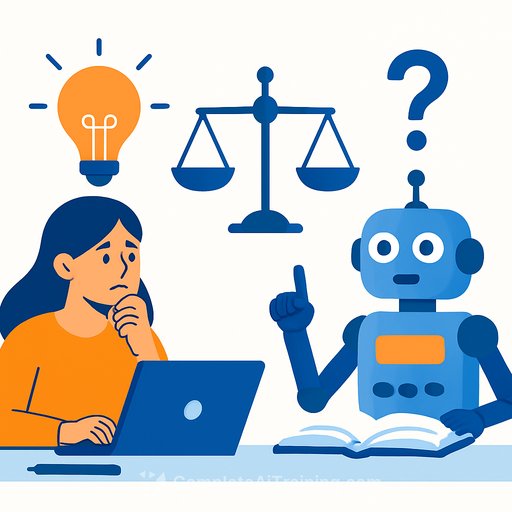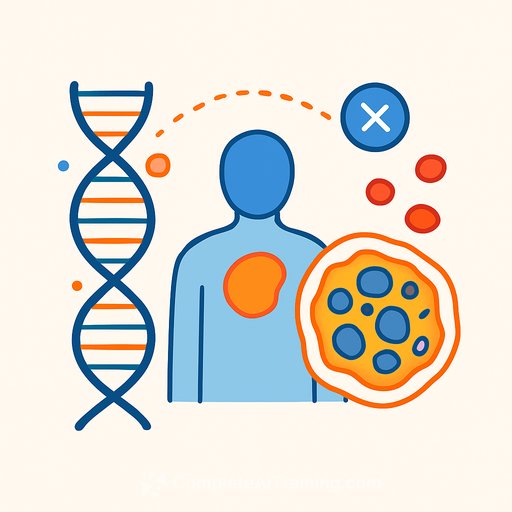Are we teaching AI competence or dependence?
A student points to three flawless paragraphs and admits they can't explain them. The prose looks impressive, but the thinking isn't there. That gap-performance without competence-is spreading across higher education.
The question isn't "Should students use AI?" It's "Can they think with it, judge it, and take ownership of the final output?" Right now, the answer is often no.
The performance paradox
Institutions rolled out prompt workshops and "responsible use" guidelines. Tool fluency improved. Intellectual growth did not.
Across studies, heavy AI use often correlates with weaker critical thinking. Students execute tasks faster, but offload the actual reasoning. The result is metacognitive laziness: doing work through AI without engaging the thinking the assignment was meant to develop.
When confidence becomes dangerous
Polished AI text creates a false sense of certainty. Students submit authoritative claims with clean citations, then struggle to tell fact from speculation when questioned. This is classic automation bias-outsourcing judgment to systems that sound confident by default.
Experiments show many learners miss AI-generated errors unless prompted to doubt them. The output looks right, so it feels right. That feeling is the trap.
The hidden curriculum of dependency
Current practices teach an unintended lesson: accept outputs, optimize prompts, move on. We see the same behavioral shifts across cohorts-more passivity, less creative problem-solving, fewer attempts to challenge or extend ideas, and thinner independent analysis.
This is not theoretical. It shows up in how students approach tasks: search first, copy structure, let the model propose claims, and skip the slow work of evaluation.
Why current assessment can't see the problem
Traditional grading rewards polished artifacts. AI produces those on demand. Students can hit rubrics without building the underlying skills those rubrics were designed to signal.
Even "AI literacy" programs often measure button-click proficiency rather than judgment, verification, or ethical reasoning. We are grading performance and calling it competence.
Build AI judgment, not just tool fluency
AI judgment is the capacity to decide when, how, and whether to use AI-and to verify and own the result. It rests on three pillars.
1) Critical evaluation practice
- Require fact-checking of AI outputs with source labeling and confidence notes.
- Have students identify logical gaps, unsupported leaps, and missing constraints in AI arguments.
- Compare model outputs against authoritative references; justify acceptance or rejection line by line.
- Practice uncertainty calibration: where could this be wrong, and how would we know?
2) Meta-cognitive awareness development
- Assign paired tasks: complete once with AI, once without. Reflect on differences in reasoning, speed, and error types.
- Track AI usage logs: prompts, iterations, decisions kept or discarded, and the rationale for each.
- Use think-aloud or brief memos to surface the student's decision process, not just the final text.
3) Intellectual ownership maintenance
- Viva-style checks: explain, defend, and adapt the work under light probing.
- Process portfolios: show the evolution from question to claim to evidence, including AI interactions.
- Independence ratio: quantify what was generated, what was edited, and what was authored from scratch.
- Ablation tasks: remove AI scaffolds and test whether the core reasoning still stands.
Course and assessment shifts that work
- Grade the process: verification steps, source quality, and reasoning clarity get explicit weight.
- Add "AI disclosure statements" with links to prompts and outputs, plus verification notes.
- Use red-team assignments: students must find and correct AI errors, then document how they detected them.
- Balance modes: time-boxed no-AI sprints for core skills; AI-allowed phases for synthesis and critique.
Faculty development essentials
- Recognize dependency signals: shallow paraphrase, missing boundary conditions, citation without reading, confident but brittle defense.
- Design for judgment: prompts that demand evaluation, not just production.
- Assess reasoning: rubrics for claim-evidence alignment, error detection, uncertainty handling, and transfer to new contexts.
Practical playbook for the next semester
- Publish an AI policy that distinguishes assistive use from replacement of thinking, with concrete examples.
- Introduce an AI verification checklist: sources cited, claims tested, numbers reproduced, assumptions stated.
- Require process artifacts: prompts, change logs, and rationale for keeping or discarding AI suggestions.
- Embed 10-minute viva spot-checks for major submissions.
- Run a "misinformation drill": seed subtle errors in AI outputs; grade on detection and correction.
- Close the loop: provide feedback on the process, not just the product.
Metrics that actually reflect competence
- Misinformation detection rate: percent of seeded errors caught without hints.
- Source quality score: proportion of claims tied to primary or high-grade secondary sources.
- Error correction latency: time from detection to verified fix with evidence.
- Uncertainty calibration: alignment between stated confidence and actual accuracy.
- Transfer performance: apply the same method to a novel problem with minimal AI prompts.
- Ownership articulation: clarity when explaining what the student authored vs. what AI proposed-and why.
The choice for higher education
We can graduate users who look competent but depend on prompts, or thinkers who can audit, adapt, and take responsibility for their work. The first is efficient in the short term. The second is what scholarship and industry need.
The problem is visible. The fixes are practical. Shift the goal from producing polished outputs to producing verified thinking. That's the path to genuine AI competence.
Further reading
UNESCO: Guidance on Generative AI in education and research
OECD: Skills Outlook on AI and learning
Resource
For structured practice on AI evaluation skills and course design, see Complete AI Training: Courses by Skill.
Your membership also unlocks:






